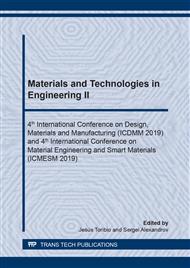p.3
p.9
p.18
p.24
p.33
p.41
p.50
p.55
Investigating the Properties and Structure of Polyurethane Elastomers with Monoethylene Glycol Chain Extender
Abstract:
The effect of monoethylene glycol (mEG) acting as chain extender in polypropylene glycol (PPG-4000) and 4,4ʹ-diphenylmethane diisocyanate (MDI) reaction was investigated. Polyurethane elastomers (PUR) were changed from flexible to rigid materials by varying the mEG content. Results show that Shore A and D hardness values trend to increase with increasing mEG content. It appears that increasing the chain extender content increases the hard segment content in the polyurethane structure. Moreover, increasing the mEG content increases Young’s modulus and the tensile strength of PUR, while elongation at break decreases. The chemical structure of the hard segment of PUR was characterized by Infrared (IR) spectroscopy. IR spectra exhibited the bands typical for PUR consisting of –NH, CH2– and C=O groups. The spectra reveal a few interactions between the polymeric chains that appear to be responsible for the shift of transmittance peak and decrease of some peak intensity. This may be due to the hard segment aggregating more to form domains in the PUR when mEG content was increased.
Info:
Periodical:
Pages:
18-23
Citation:
Online since:
April 2020
Price:
Сopyright:
© 2020 Trans Tech Publications Ltd. All Rights Reserved
Share:
Citation:


